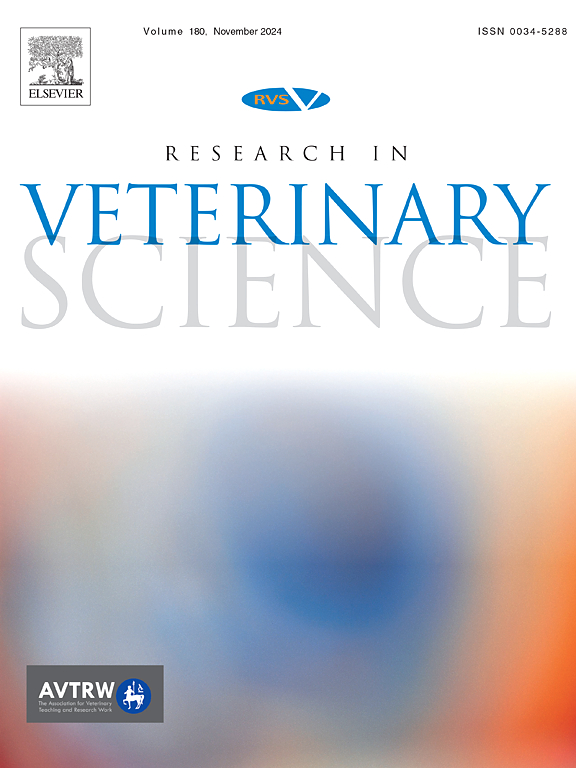西班牙南部绵羊(Ovis aries)和欧洲骡(Ovis aries musimon)中犬新孢子虫的流行病学监测。
IF 2.2
3区 农林科学
Q1 VETERINARY SCIENCES
引用次数: 0
摘要
犬新孢子虫(Neospora caninum)是一种原生动物,以犬科动物为最终宿主,以其他哺乳动物(主要是反刍动物)为中间宿主,其生命周期为面异口同源。这种寄生虫被认为是导致牛流产的主要病原体之一。虽然其他家养和野生反刍动物中也有生殖障碍的报道,但牛以外的反刍动物物种中犬囊虫的流行病学数据仍然有限。在此,我们评估了西班牙南部绵羊(Ovis aries)和欧洲驼鹿(Ovis aries musimon)的血清流行率以及与接触犬白头翁相关的风险因素。使用基于重组抗原 NcGRA7 的内部时间分辨荧光免疫测定法对 390 只绵羊和 387 只散养骡子的血清样本进行了犬结核抗体检测。绵羊的个体血清阳性率为 26.2%(95 %CI:22.0-30.7),骡的个体血清阳性率为 5.7%(95 %CI:3.8-8.5)。抽样调查的 26 个养羊场(100%)和 18 个狩猎场中的 8 个(44.4%)至少有一个动物血清阳性。牧场中狗的数量(≥3 只)和绵羊的品种(纯种)是绵羊感染犬结核的潜在风险因素。我们的研究结果表明,N. caninum 在西班牙南部的养羊场中高度流行。应采取控制措施,限制羊群接触这种原生动物。尽管我们首次证实西班牙的欧洲绒螯羊体内存在抗 N. caninum 的抗体,尽管发现的血清流行率相对较低,但这种寄生虫对绒螯羊种群的影响仍有待进一步研究。本文章由计算机程序翻译,如有差异,请以英文原文为准。
Epidemiological surveillance of Neospora caninum in sheep (Ovis aries) and European mouflon (Ovis aries musimon) in southern Spain
Neospora caninum is a protozoan with a facultative heteroxenous life cycle, with canids as the definitive hosts and other mammals, mainly ruminants, acting as intermediate hosts. This parasite is recognized as one of the major abortifacient pathogens in cattle. Although reproductive disorders have also been reported in other domestic and wild ruminants, epidemiological data on N. caninum in ruminant species other than cattle is still limited. Here, we evaluate the seroprevalence and risk factors associated with N. caninum exposure in sheep (Ovis aries) and European mouflon (Ovis aries musimon) in southern Spain. Serum samples from 390 sheep and 387 free-ranging mouflons were tested for antibodies against N. caninum using in-house time-resolved fluorescence immunoassay based on NcGRA7 as a recombinant antigen. The individual seroprevalence was 26.2 % (95 %CI: 22.0–30.7) in sheep and 5.7 % (95 %CI: 3.8–8.5) in mouflons. At least one seropositive animal was detected in all the 26 sheep farms (100 %) and in eight of the 18 (44.4 %) hunting estates sampled. The presence of dogs on the farm (≥3) and the sheep breed (purebred) were potential risk factors associated with exposure to N. caninum in sheep. Our results indicate a high circulation of N. caninum in sheep farms in southern Spain. Control measures should be implemented to limit the exposure to this protozoan in sheep flocks. Although we have confirmed for the first time the presence of anti- N. caninum antibodies in European mouflon in Spain, and, despite the relatively low seroprevalence found, the impact of this parasite on mouflon populations should be further studied.
求助全文
通过发布文献求助,成功后即可免费获取论文全文。
去求助
来源期刊

Research in veterinary science
农林科学-兽医学
CiteScore
4.40
自引率
4.20%
发文量
312
审稿时长
75 days
期刊介绍:
Research in Veterinary Science is an International multi-disciplinary journal publishing original articles, reviews and short communications of a high scientific and ethical standard in all aspects of veterinary and biomedical research.
The primary aim of the journal is to inform veterinary and biomedical scientists of significant advances in veterinary and related research through prompt publication and dissemination. Secondly, the journal aims to provide a general multi-disciplinary forum for discussion and debate of news and issues concerning veterinary science. Thirdly, to promote the dissemination of knowledge to a broader range of professions, globally.
High quality papers on all species of animals are considered, particularly those considered to be of high scientific importance and originality, and with interdisciplinary interest. The journal encourages papers providing results that have clear implications for understanding disease pathogenesis and for the development of control measures or treatments, as well as those dealing with a comparative biomedical approach, which represents a substantial improvement to animal and human health.
Studies without a robust scientific hypothesis or that are preliminary, or of weak originality, as well as negative results, are not appropriate for the journal. Furthermore, observational approaches, case studies or field reports lacking an advancement in general knowledge do not fall within the scope of the journal.
 求助内容:
求助内容: 应助结果提醒方式:
应助结果提醒方式:


